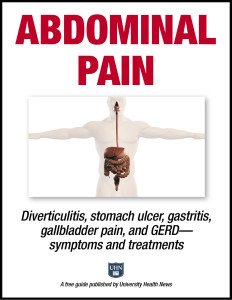Gallbladder and Gallstones: How to Protect Yourself from Painful Attacks
The gallbladder, a small, pear-shaped pouch beneath the liver, plays an essential role in maintaining a smooth and healthy digestion. Here’s how it works. First, the liver produces bile (a combination of water, acid, cholesterol, bilirubin, and lecithin), to digest fats in the small intestine. As the bile is produced, the gallbladder stores it until needed. When you eat fat, the gallbladder sends bile through a system of tubes (called ducts) leading into the small intestine where it break ups the fat.
Too much cholesterol or bilirubin in bile, however, can form crystals that clump together into gallstones. A problem arises when a gallstone gets caught in a duct and blocks the normal flow of bile. This causes inflammation of the gallbladder, a condition called cholecystitis.
Who Is at Risk for Gallstones?
Women between ages 20 and 60 are much more likely to develop gallstones than men. After age 60, the disparity between men and women disappears. Excess estrogen appears to increase cholesterol levels, which may explain why women taking birth-control pills or hormone therapy have higher risks.
Diabetes, being overweight, or losing a lot of weight quickly, also raises your risk of gallstones. Genetics play a role, too: Native and Mexican-Americans have a strong genetic predisposition for gallstones, as does anyone with a family history of gallstones.
Fight Back!
Download this expert FREE guide, Abdominal Pain: Diverticulitis, stomach ulcer, gastritis, gallbladder pain, and GERD—symptoms and treatments.
Learn more about your digestive system, how it works, why and how it sometimes acts up, and most important, what you can do about it.
Know the Symptoms of Gallstones–and How to Treat Them
Symptoms of gallstones include the following:
- Severe pain in the upper-right side of the abdomen that waxes and wanes and lasts from 30 minutes to several hours
- Pain that radiates to the back, between the shoulder blades, and under the right shoulder
- Nausea or vomiting
- Sweating, fever and chills
- Clay-colored stools
- Dark-colored urine
If a stone is stuck in the common bile duct, bile can back up and enter the blood, causing jaundice, a condition where the skin and whites of the eyes appear yellow.
To diagnose gallstones, your doctor will probably do an ultrasound or a test called a cholescintigraphy. Here, the patient is injected with a radioactive dye, and a gamma ray camera tracks the flow of the dye into and out of the gallbladder. Additionally, blood tests may be used to look for signs of infection, obstruction, or jaundice.
If the symptoms are severe or suggest acute inflammation, surgery may be required. Gallbladder removal is one of the most commonly performed surgical procedures in the United States. A laparoscopic cholecystectomy requires only small incisions and produces minimal scarring.
If the pain from gallstones is mild and intermittent, simply avoiding fatty foods may prevent or reduce the pain episodes.
For further reading, see the following University Health News posts:
- “How to Identify Gallbladder Pain: Gallstone Diagnosis and Treatment“
- “What Does a Gallbladder Attack Feel Like?“
- “The Gallbladder Diet: How Your Food Choices Can Lower the Risk of Gallstones”
Originally published May 2016.
The post Gallbladder and Gallstones: How to Protect Yourself from Painful Attacks appeared first on University Health News.
Read Original Article: Gallbladder and Gallstones: How to Protect Yourself from Painful Attacks »
Powered by WPeMatico




